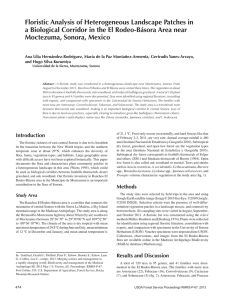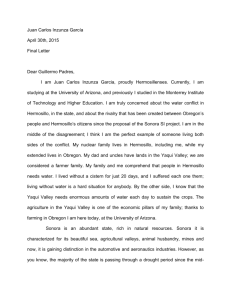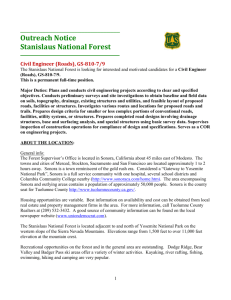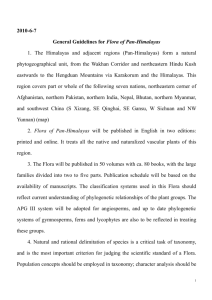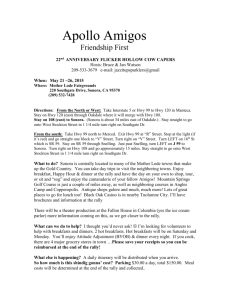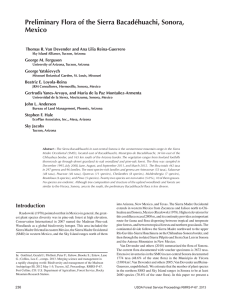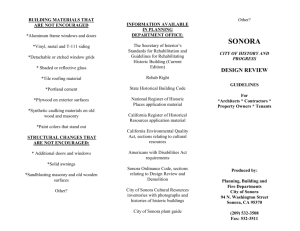Preliminary Flora of Ojo de Agua Tonibabi, Sierra La
advertisement
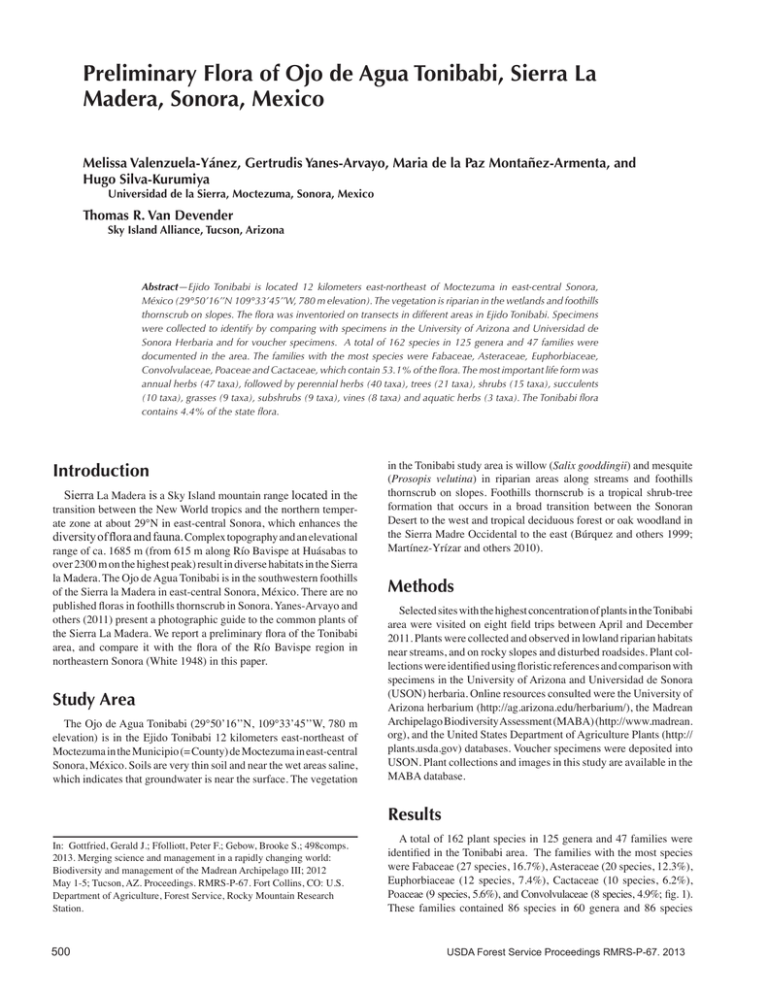
Preliminary Flora of Ojo de Agua Tonibabi, Sierra La Madera, Sonora, Mexico Melissa Valenzuela-Yánez, Gertrudis Yanes-Arvayo, Maria de la Paz Montañez-Armenta, and Hugo Silva-Kurumiya Universidad de la Sierra, Moctezuma, Sonora, Mexico Thomas R. Van Devender Sky Island Alliance, Tucson, Arizona Abstract—Ejido Tonibabi is located 12 kilometers east-northeast of Moctezuma in east-central Sonora, México (29°50’16’’N 109°33’45’’W, 780 m elevation). The vegetation is riparian in the wetlands and foothills thornscrub on slopes. The flora was inventoried on transects in different areas in Ejido Tonibabi. Specimens were collected to identify by comparing with specimens in the University of Arizona and Universidad de Sonora Herbaria and for voucher specimens. A total of 162 species in 125 genera and 47 families were documented in the area. The families with the most species were Fabaceae, Asteraceae, Euphorbiaceae, Convolvulaceae, Poaceae and Cactaceae, which contain 53.1% of the flora. The most important life form was annual herbs (47 taxa), followed by perennial herbs (40 taxa), trees (21 taxa), shrubs (15 taxa), succulents (10 taxa), grasses (9 taxa), subshrubs (9 taxa), vines (8 taxa) and aquatic herbs (3 taxa). The Tonibabi flora contains 4.4% of the state flora. Introduction Sierra La Madera is a Sky Island mountain range located in the transition between the New World tropics and the northern temperate zone at about 29°N in east-central Sonora, which enhances the diversity of flora and fauna. Complex topography and an elevational range of ca. 1685 m (from 615 m along Río Bavispe at Huásabas to over 2300 m on the highest peak) result in diverse habitats in the Sierra la Madera. The Ojo de Agua Tonibabi is in the southwestern foothills of the Sierra la Madera in east-central Sonora, México. There are no published floras in foothills thornscrub in Sonora. Yanes-Arvayo and others (2011) present a photographic guide to the common plants of the Sierra La Madera. We report a preliminary flora of the Tonibabi area, and compare it with the flora of the Río Bavispe region in northeastern Sonora (White 1948) in this paper. Study Area The Ojo de Agua Tonibabi (29°50’16’’N, 109°33’45’’W, 780 m elevation) is in the Ejido Tonibabi 12 kilometers east-northeast of Moctezuma in the Municipio (= County) de Moctezuma in east-central Sonora, México. Soils are very thin soil and near the wet areas saline, which indicates that groundwater is near the surface. The vegetation in the Tonibabi study area is willow (Salix gooddingii) and mesquite (Prosopis velutina) in riparian areas along streams and foothills thornscrub on slopes. Foothills thornscrub is a tropical shrub-tree formation that occurs in a broad transition between the Sonoran Desert to the west and tropical deciduous forest or oak woodland in the Sierra Madre Occidental to the east (Búrquez and others 1999; Martínez-Yrízar and others 2010). Methods Selected sites with the highest concentration of plants in the Tonibabi area were visited on eight field trips between April and December 2011. Plants were collected and observed in lowland riparian habitats near streams, and on rocky slopes and disturbed roadsides. Plant collections were identified using floristic references and comparison with specimens in the University of Arizona and Universidad de Sonora (USON) herbaria. Online resources consulted were the University of Arizona herbarium (http://ag.arizona.edu/herbarium/), the Madrean Archipelago Biodiversity Assessment (MABA) (http://www.madrean. org), and the United States Department of Agriculture Plants (http:// plants.usda.gov) databases. Voucher specimens were deposited into USON. Plant collections and images in this study are available in the MABA database. Results In: Gottfried, Gerald J.; Ffolliott, Peter F.; Gebow, Brooke S.; 498comps. 2013. Merging science and management in a rapidly changing world: Biodiversity and management of the Madrean Archipelago III; 2012 May 1-5; Tucson, AZ. Proceedings. RMRS-P-67. Fort Collins, CO: U.S. Department of Agriculture, Forest Service, Rocky Mountain Research Station. 500 A total of 162 plant species in 125 genera and 47 families were identified in the Tonibabi area. The families with the most species were Fabaceae (27 species, 16.7%), Asteraceae (20 species, 12.3%), Euphorbiaceae (12 species, 7.4%), Cactaceae (10 species, 6.2%), Poaceae (9 species, 5.6%), and Convolvulaceae (8 species, 4.9%; fig. 1). These families contained 86 species in 60 genera and 86 species USDA Forest Service Proceedings RMRS-P-67. 2013 Preliminary Flora of Ojo de Agua Tonibabi, Sierra La Madera, Sonora, Mexico Valenzuela-Yánez and others Figure 1—Species and genera in the most important families in the Tonibabi flora. (53.1% of the flora). The genera with the most species were Acacia, Boerhavia, Bouteloua, Bursera, Desmodium, Euphorbia, Ipomoea, Jatropha, Opuntia, and Portulaca with 19.5% of the total species. The most important life forms in Tonibabi are herbs and trees (66.7% of the flora), followed by cacti and grasses (11.7% each), shrubs (9.5%), subshrubs (5.5%), vines (4.9%) and aquatic herbs (1.8%). Riparian species are Goodding willow (Salix gooddingii), mesquite (Prosopis velutina), tésota (Acacia occidentalis), batamote (Baccharis salicifolia), cadillo (Xanthium strumarium), and Mimulus guttatus. Matelea pringlei and Tragia jonesii are regional endemic species only found in Sonora. Pseudabutilon thurberi also occurs in adjacent Arizona. Amoreuxia palmatifida and Olneya tesota have a PR (Protected) status under NOM-059-SEMARNAT-2010. Only four species in the Tonibabi flora (2.5%) were non-native plants: Nasturtium officinale, Nicotiana glauca, Melinis repens and Pennisetum ciliare (Van Devender and others 2009). Discussion The State of Sonora has a diverse flora with 3483 species (3237 natives) including 104 varieties, 43 subspecies, and 30 interspecific hybrids. Only 78 taxa (68 species, 8 subspecies, and 2 varieties) are endemic to mainland Sonora (Van Devender and others 2010). The Tonibabi flora has widespread riparian/wetlands species and typical tropical foothills thornscrub species. As in many floras, herbs are numerically dominant in the flora, with relatively few trees, shrubs and large succulents such as Bursera fagaroides, B. laxiflora, Mimosa USDA Forest Service Proceedings RMRS-P-67. 2013 distachya, Lysiloma divaricatum, Jatropha cordata, and Stenocereus thurberi, structural dominants in the vegetation. Trees with 21 species are only 13% of the flora. Stephen S. White from the University of Michigan led expeditions to study the flora of the Río Bavispe Region in northeastern Sonora from 1938 to 1941 (White 1948). He collected in a wide range of habitats in the region, resulting in 1200 species (currently 995 taxa after revision) in 549 genera in 114 families. In July1938, he collected in the Moctezuma area including eleven specimens at Tonibabi. Eustoma exaltatum, Martynia althaeifolia, Phaulothamnus spinescens, and Samolus valerandi ssp. parviflorus were not found in the present study. Catchfly prairie gentian (E. exaltatum) is an herb with showy lavender flowers found in seeps and springs and is rare in Sonora. Only 76 species (47%) in the Tonibabi flora are shared with the Río Bavispe flora, reflecting White’s brief visit to the area, and that foothills thornscrub is only found in the Río Bavispe Region in the southern end of the Sierra El Tigre west across the to the Sierra la Madera. Tonibabi with its extensive wetlands is a unique area in foothills thornscrub. Large areas of whitish soil visible from satellite images suggest that the wetlands were much more extensive in the past. Study of pollen in the spring sediments show that the ciénega formed 8300 years ago in the early Holocene and was wetter than today until after 2300 years ago (Espinoza-Encinas 2012). Plants in the Ojo de Agua Tonibabi are disjunct from other wetlands and possibly relict populations from wetter past climates. 501 Valenzuela-Yánez and others Acknowledgments We thank George M. Ferguson for his careful review. References Búrquez, Alberto; Martínez-Yrízar, Angelina; Felger, Richard S.; and Yetman, David. 1999. Vegetation and habitat diversity at the southern edge of the Sonoran Desert. Pg. 36-67 in Robichaux, Robert H., ed. Ecology of Sonoran Desert plants and plant communities. Tucson: University of Arizona. Espinoza-Encinas, Iván Rosario. 2012. Paleoambientes Cuaternarios de la Ciénega de Tonibabi, Moctezuma, Sonora. Masters thesis. Hermosillo: Universidad de Sonora. 144 p. MABA database (Madrean Archipelago Biodiversity Assessment). Online: http://www.madrean.org/maba/symbflora/ Martínez-Yrízar, Angelina; Felger, Richard S.; and Búrquez, Alberto. 2010. Los ecosistemas terrestres: un diverso capital natural. Pg. 129-156 in MolinaFreaner, Francisco E.; and Van Devender, Thomas R. eds. Diversidad Biológica de Sonora. Hermosillo: Universidad Autónoma Nacional de México. Norma Oficial Mexicana. 2010. NOM-059-SEMARNAT-2010. Diario Oficial de la Federación. Segunda sección. Jueves 30 de diciembre de 2010. Mexico. 78 p. Preliminary Flora of Ojo de Agua Tonibabi, Sierra La Madera, Sonora, Mexico Van Devender, Thomas R.; Felger, Richard S.; Fishbein, Mark; [and others]. 2010. Biodiversidad de las plantas vasculares. Pg. 229-261 in MolinaFreaner, Francisco E.; and Van Devender, Thomas R. eds. Diversidad Biológica de Sonora. Hermosillo: Universidad Autónoma Nacional de México. Online: http://www.skyislandalliance.org/Sonoran%20vascular%20plants-VanDevender%20et%20al.2010.pdf. Van Devender, Thomas R.; Felger, Richard S.; Reina-Guerrero, Ana L.; and Sánchez–Escalante, J. Jesús. 2009. Sonora: Non-native and invasive plants. Pp. 85-124 in Van Devender, Thomas R.; Espinosa-García, Francisco J.; Harper-Lore, Bonnie L.; and Hubbard, Tani. eds., Invasive plants on the move. Controlling them in North America. Proceedings of Weeds Across Borders 2006 Conference; Hermosillo, Sonora; May 25-28, 2006. Tucson, AZ: Sky Island Alliance. Online: http://www.skyislandalliance.org/WAB06c19-Van%20Devender%20et%20al-Sonoran%20non-natives-Jan08.pdf. White, Stephen S. 1948. The vegetation and flora of the region of the Río de Bavispe in northeastern Sonora, Mexico. Lloydia.11: 229‑302. Yanes-Arvayo, Gertrudis; Montañez-Armenta, María de la Paz; SilvaKurumiya, Hugo; [and others]. 2011. Catálogo de Plantas de Sierra La Madera. Arbóreas, Arbustivas y Herbáceas. Universidad de la Sierra, Hermosillo, Sonora. The content of this paper reflects the views of the authors, who are responsible for the facts and accuracy of the information presented herein. 502 USDA Forest Service Proceedings RMRS-P-67. 2013
